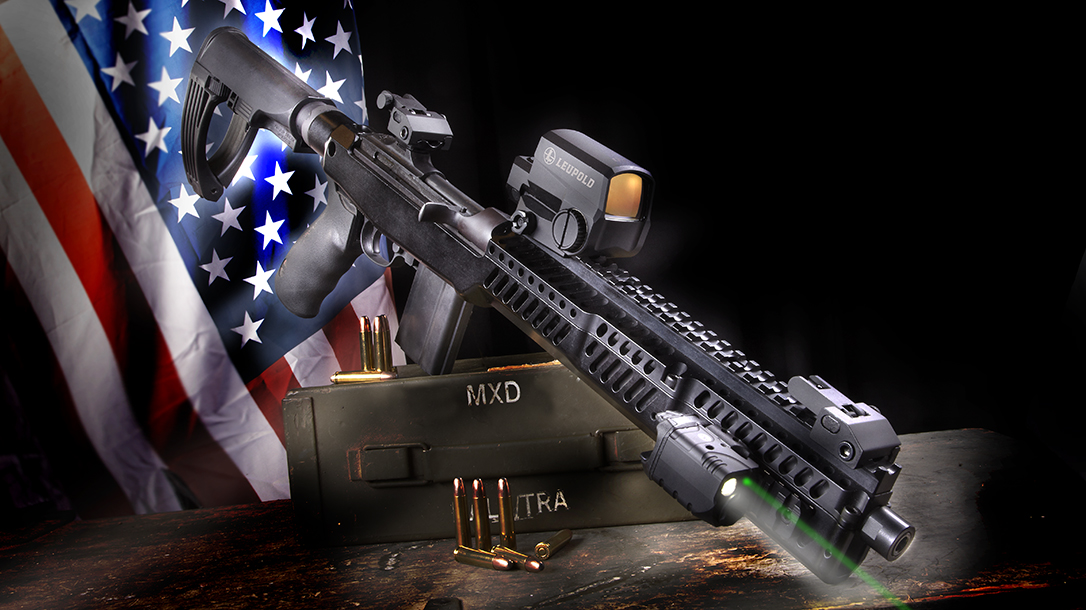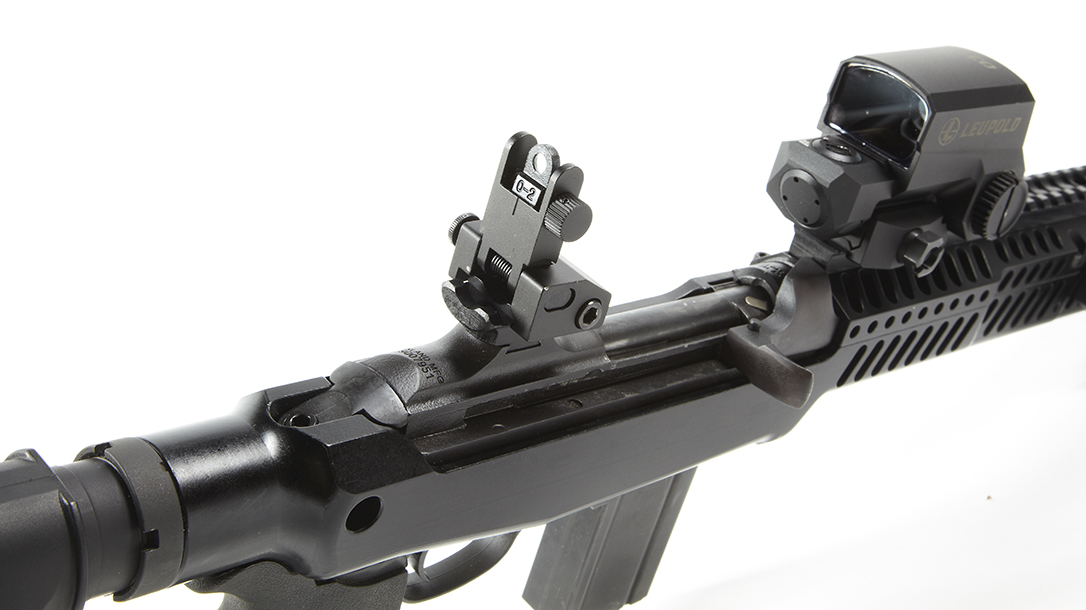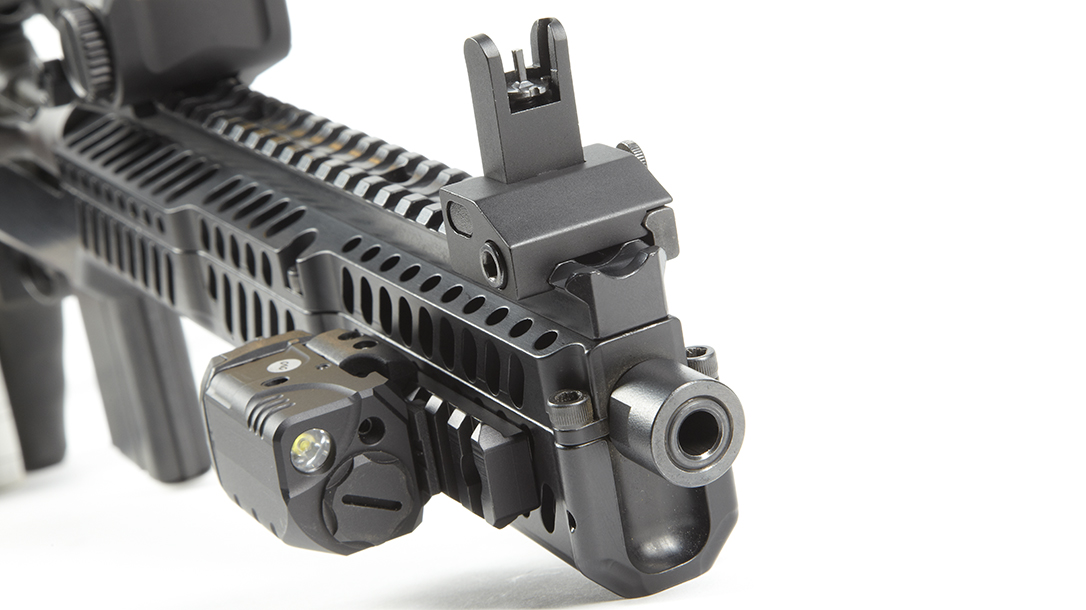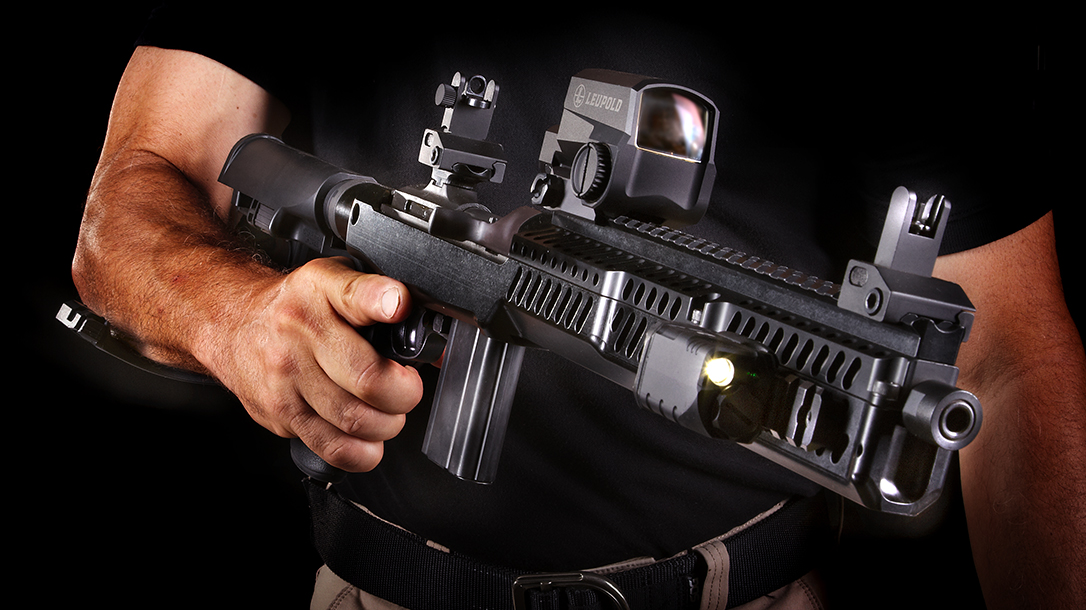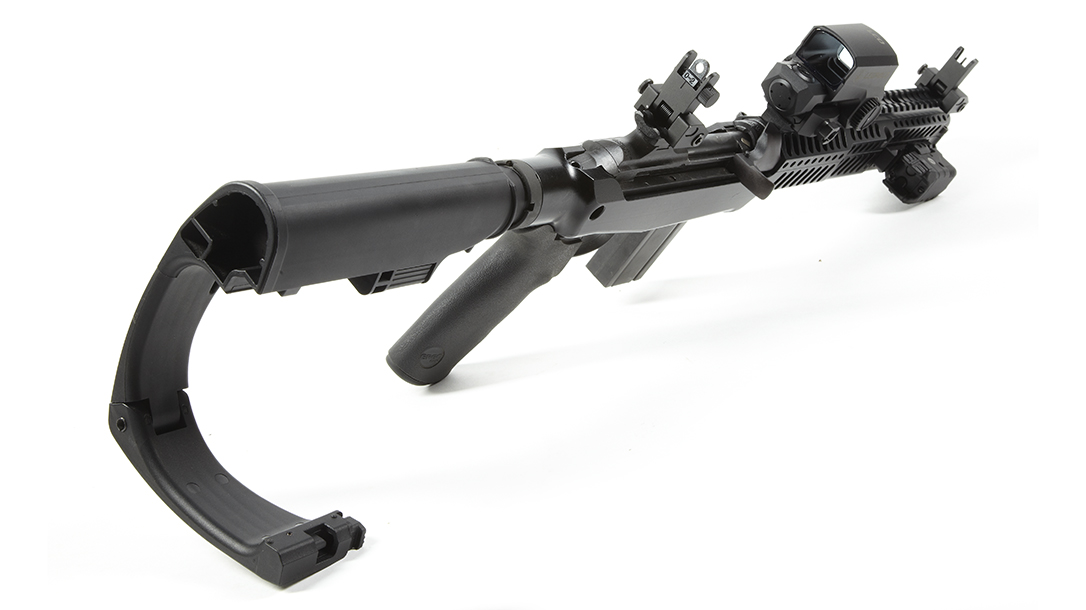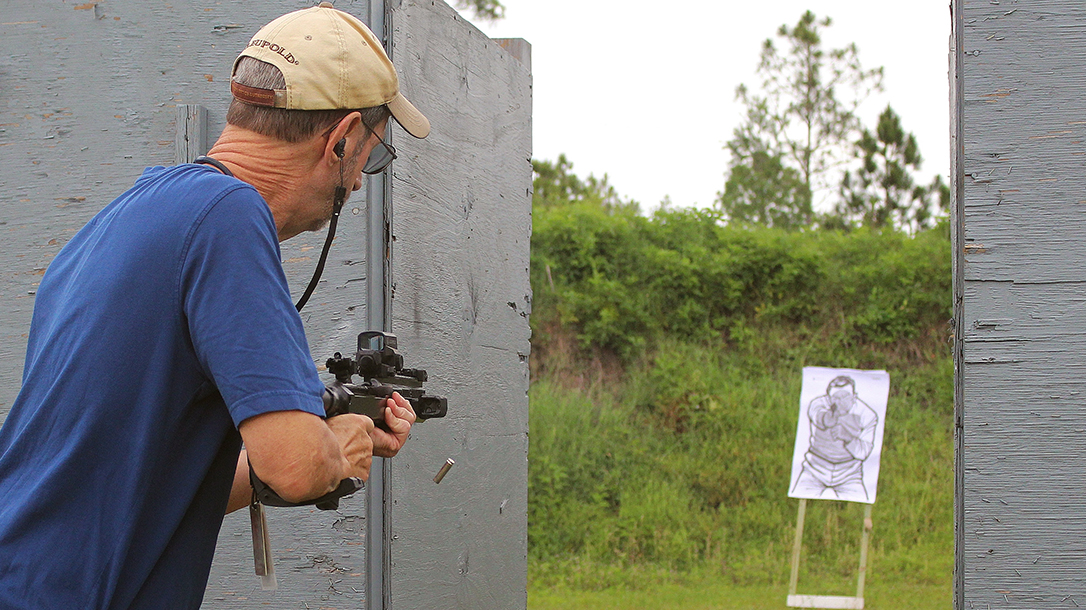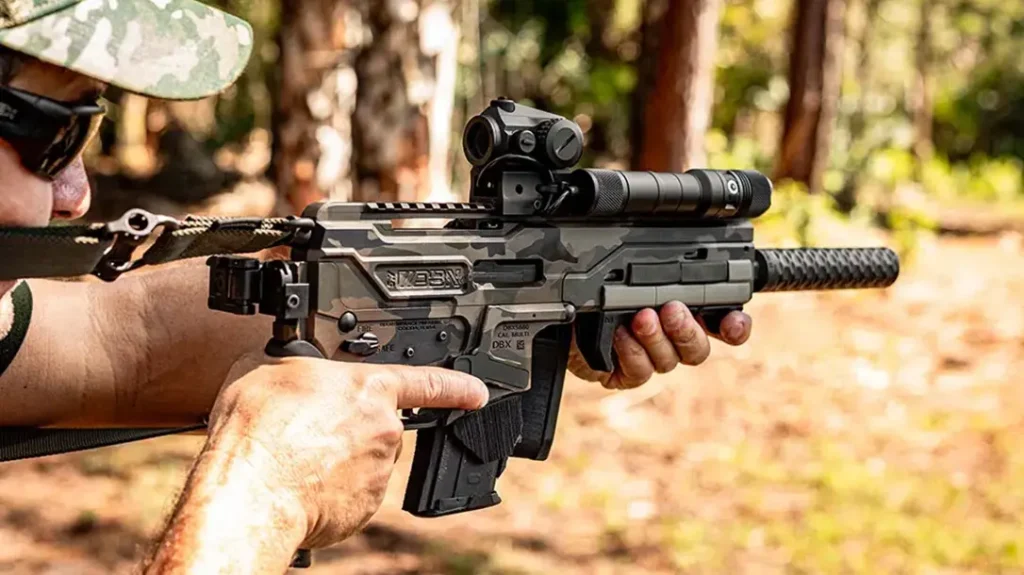Inland’s new M1 Carbine-based M30-P is definitely a large defensive pistol for the 21st century. This new handgun takes up where the M1 “Enforcer” pistol left off when production ceased in the late 20th century.
The ballistics of the .30 Carbine cartridge may be close to ideal for use in today’s heavily populated urban centers because of its limited muzzle blast and recoil. On the downside, however, the minute you say “.30 Carbine,” a lot of people think about this cartridge’s reputation for poor stopping power in World War I and Korea. But that belief concerns military carbines using ball ammo. Today, six companies produce self-defense loads for the .30 Carbine, so the stopping power issue needs to be revisited. In addition, there are stories about the low quality of commercial carbines made after WWII. I’ve seen some poorly made commercial carbines from time to time, but this Inland gun isn’t one of them.
Advertisement — Continue Reading Below
Old Meets New
The Inland M30-P is a radical departure from earlier M1 “Enforcer” pistols made by Universal and Iver Johnson. In fact, it has many new features like a sturdy Sage International Enhanced Battle Rifle (EBR) chassis made of hardcoat anodized aircraft-grade aluminum. The M30-P’s chassis has a top rail for mounting optics, and it also comes with folding battle sights. The sides of the chassis are ventilated for cooling and weight reduction. The forend is also drilled and tapped for adding short rail segments. Additionally, the chassis has attachments for mounting quick-release sling swivels.
The rear of the chassis is designed for mounting an arm brace, and a Gear Head Works Tailhook Mod 2 is included. You’ll also find a comfortable Ergo rubber-overmolded pistol grip with subtle finger grooves.
This new pistol has a 12-inch barrel that delivers especially good velocities given the fact that it is 6 inches shorter than the military carbine’s barrel. The shorter barrel makes it handier in close-quarters tactical situations than the original M1 Carbine. The company also threaded the muzzle for a suppressor.
Advertisement — Continue Reading Below
My test pistol’s overall quality was good. In fact, the parts were well conformed, except for a few tool marks on the chassis where it was relieved above the trigger guard. The bolt moved freely without any wobble. Also, the two-stage trigger broke between 5.5 and 6 pounds and was fairly smooth. The crown of the muzzle was even and slightly recessed, and the bore was shiny with clean-cut rifling. With a Leupold LCO and Crimson Trace light/laser unit, the M30-P weighed just 7 pounds with a decidedly muzzle-heavy balance.
The M30-P operates just like any other version of the M1 Carbine. To chamber a round, fully insert a magazine (one 10-rounder is included), pull the bolt handle all the way back and let it go. When shooting for recreational purposes and at many other times, the safety should be activated before inserting the magazine. The safety is located at the front of the trigger guard. Don’t confuse it for the magazine release, which is just in front of the safety. Lastly, the bolt does not automatically lock open after firing the last round when using GI-type magazines, but there is a manually operated bolt catch on the upper right side of the receiver.
Stopping Power
The M1 Carbine and its cartridge were originally developed to provide rear-area troops, officers and various support staff with a gun that had more firepower and range than the M1911. But while that .45 ACP pistol had a legendary reputation for stopping power, the carbine suffered from just the opposite. In fact, I knew two men who personally saw enemy soldiers hit in the torso by multiple .30 Carbine rounds and still continue to fight.
Advertisement — Continue Reading Below
On the other hand, Jim Cirillo used an M1 Carbine on the NYPD’s stakeout squad. However, his carbine was modified so it reliably fed Winchester’s Hollow Soft Point load, which is still available today. Well-known trainer Vicki Farnam also uses an M1 Carbine for hunting. She prefers the now-discontinued 100-grain CorBon DPX ammo. And one time when she was hunting with her husband, she stopped a 600-pound wild boar’s charge with a single shot placed just under the boar’s right eye. So, as you can see, if there’s a stopping power issue with the .30 Carbine, it all depends on which load is used. While researching this article I found six companies currently producing .30 Carbine loads for self-defense: Buffalo Bore, Federal, Hornady, Winchester, Remington and Underwood.
But how does the .30 Carbine compare to other handgun rounds? When fired in the Inland M30-P, Hornady’s 110-grain Critical Defense FTX load produces 890 foot-pounds of energy (fpe) at the muzzle, which equals many .44 Magnum loads. The Hornady load’s average muzzle velocity is 1,909 fps from the M30-P, which is faster than any common .44 Magnum load.
According to well-known forensic pathologist Dr. Vincent Di Maio in Gunshot Wounds, the .30 Carbine is neither a rifle or a pistol cartridge. When loaded with a FMJ bullet, he writes that it produces wounds similar to a .44 Magnum. When loaded with an expanding bullet, it appears to transfer energy like a rifle bullet because it produces dramatic tissue destruction in areas of the torso that are remote from the permanent wound channel. So, at CQB distances where the velocity is still high, a .30 Carbine bullet designed for personal defense appears to be superior in its wounding capability than pistol cartridges up to and including the .44 Magnum.
Advertisement — Continue Reading Below
Rounds Downrange
I tested the Inland M30-P at the Flagler Gun Club, as well as the Volusia County Gun & Hunt Club with, as mentioned, a Leupold LCO and a Crimson Trace Rail Master Pro. Once I sighted the rifle using an MTM K-Zone rest, I fired three 5-shot groups at 100 yards with Hornady’s 100-grain Critical Defense FTXs and Underwood’s 85-grain Xtreme Cavitator ammo. The Hornady load proved to be the most accurate with a 4.27-inch average for three groups. The Underwood ammo averaged 6.33 inches. The Hornady load’s velocity was 1,909 fps while the Underwood’s was 1,943 fps.
I also used the M30-P to run three different tactical drills. The first was a three-target body-armor drill on silhouette targets representing armed assailants several feet from each other and 15 yards from the firing line. I double-tapped each target with one shot to the body and one to the head. I ran this drill twice, starting at low-ready, and each repetition resulted in six good hits. Using a Competition Electronics shot timer, the average of the two runs was 8.86 seconds.
The second drill used photographic scenario targets from Law Enforcement Targets. It involved taking down threats in a hypothetical parking garage. Then, you encounter an armed member of a robbery crew waiting in ambush behind a car and fire until the threat is neutralized. Then you “pie” the corner of a short hallway to your left and see a target depicting a second armed assailant pointing a gun at you. You drop that threat and move to the end of the hallway, where you find an “assailant” holding a female cashier hostage. You then shoot the robber three times in the torso. I ran this drill twice, firing 16 shots each repetition, and my average time was 42.04 seconds. All of my shots were on target and none hit the hostage.
Advertisement — Continue Reading Below
The final drill involved a hypothetical home-invasion scenario where you retrieve your gun after noticing an armed assailant through the front window of your home. At the buzzer, you hustle to the front door and carefully pie the doorway to your left until you see the attacker. Then, you fire two shots to the assailant’s body, and average time for three runs was 8.7 seconds. All of my shots were left-center on the torso between the navel and the lower sternum.
For Today’s Threats
The Inland M30-P isn’t your grandfather’s M1 Enforcer. In fact, it’s a state-of-the-art M1 pistol capable of handling a wide variety of 21st century tactical scenarios. Of course, the latest in technology doesn’t come cheap, and this pistol’s $1,729 MSRP is not inexpensive. Then again, this pistol does what it is designed to do.
Advertisement — Continue Reading Below
Inland M30-P Specs
- Caliber: .30 Carbine
- Barrel: 12″
- OA Length: 26.75-29.38″
- Weight: 5.5 lbs. (empty)
- Grip: Ergo rubber
- Sights: Flip-up front and rear
- Action: Piston-operated semi-auto
- Finish: Matte black
- Capacity: 10
- MSRP: $1,729
For more information about the Inland M30-P, please visit inland-mfg.com.
